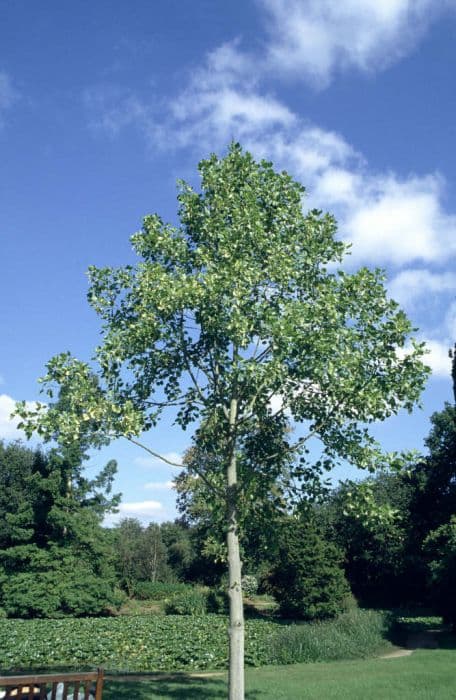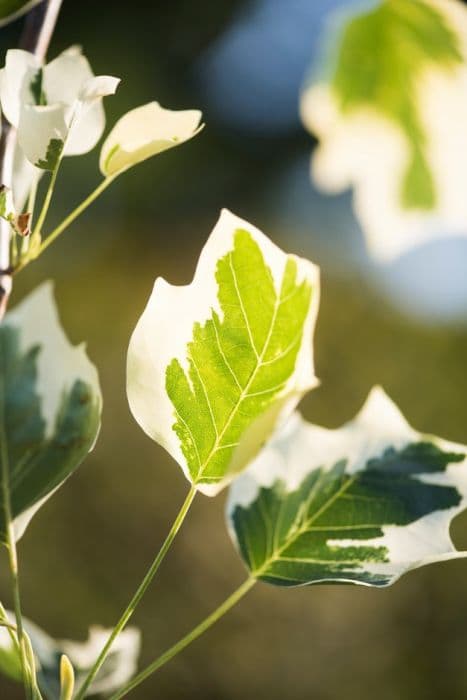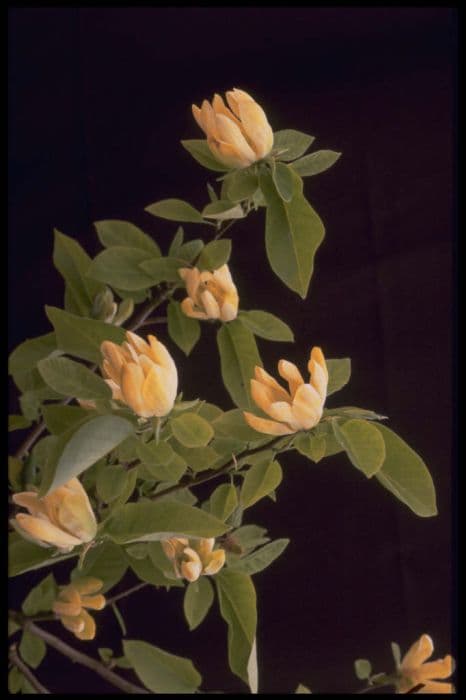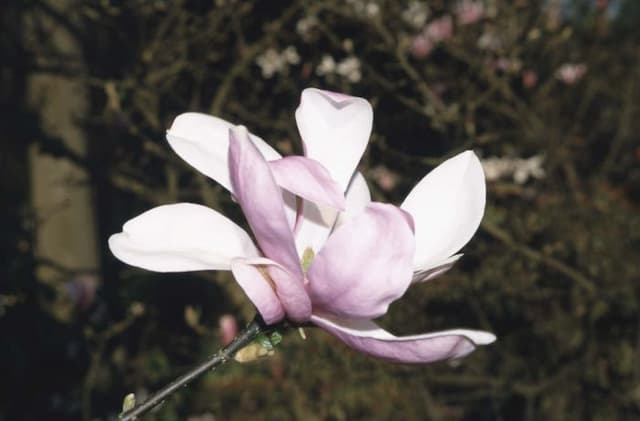Black lily magnolia Magnolia liliiflora 'Nigra'

ABOUT
'Nigra' is a spreading medium-sized deciduous shrub with glossy elliptic leaves to 20cm in length. Flowers erect, narrowly tulip-shaped, with oblong, deep reddish-purple tepals 12cm in length, paler within
About this plant
 Names
NamesFamily
Magnoliaceae.
Synonyms
Black Lily Magnolia, Purple Magnolia, Red Magnolia, Woody-orchid, Japanese Magnolia.
Common names
Magnolia quinquepeta, Magnolia liliifera, Yulania liliiflora, Yulania quinquepeta.
 Characteristics
CharacteristicsLife cycle
Perennials
Foliage type
Deciduous
Color of leaves
Green
Flower color
Purple
Height
8-12 feet (2.4-3.7 meters)
Spread
6-8 feet (1.8-2.4 meters)
Plant type
Shrub
Hardiness zones
5-9
Native area
Asia
Benefits
 General Benefits
General Benefits- Ornamental Appeal: Magnolia liliiflora 'Nigra', commonly known as Black Lily Magnolia, features deep purple-pink flowers that add aesthetic value to gardens.
- Scented Flowers: The flowers emit a pleasant fragrance, enhancing the sensory experience in the garden.
- Attracts Pollinators: Its blooms attract bees and other pollinators, supporting local ecosystems.
- Seasonal Interest: Provides a striking floral display in the spring, offering seasonal interest in garden landscapes.
- Compact Growth: Its relatively small size makes it suitable for smaller gardens or limited spaces.
- Drought Tolerance: Once established, it exhibits a degree of drought tolerance, reducing the need for frequent watering.
- Minimal Maintenance: Black Lily Magnolia requires minimal pruning and upkeep compared to other ornamental shrubs.
- Cold Tolerant: It has a good degree of cold tolerance, making it suitable for a range of climates.
 Medical Properties
Medical Properties- Anti-inflammatory: Magnolia liliiflora 'Nigra', commonly known as Mulan magnolia, has been used in traditional Chinese medicine for its potential to reduce inflammation.
- Analgesic: Some compounds in the plant may have pain-relieving properties.
- Antioxidant: The bark and flower buds contain magnolol and honokiol, which are compounds with antioxidant effects.
- Anxiolytic: Extracts from the plant are believed to have a calming effect and could help reduce anxiety.
- Neuroprotective: Potentially protective against neurological disorders due to its bioactive compounds.
- Antimicrobial: The plant's extracts may have properties that inhibit the growth of certain bacteria and fungi.
- Anti-cancer: Early research suggests that some chemical compounds found in the plant may have anti-cancer properties.
 Air-purifying Qualities
Air-purifying QualitiesThis plant is not specifically known for air purifying qualities.
 Other Uses
Other Uses- Magnolia liliiflora 'Nigra', commonly known as Black Lily Magnolia, can be used in floral arrangements due to its striking dark purple-colored flowers, adding a dramatic effect to bouquets and indoor displays.
- The wood of the Black Lily Magnolia is occasionally used in woodworking for its fine grain and workability, although this is not a common practice due to the size of the tree.
- The bark of the Black Lily Magnolia may be utilized in natural fabric dyeing processes, offering a range of tones from green to brown depending on the mordant used.
- Because of their large, showy flowers, Black Lily Magnolia blossoms are sometimes crystallized or candied for decorative dessert garnishes in high-end culinary presentations.
- In crafting, the dried seed pods and cones from Black Lily Magnolia can be painted and used as ornaments in decorations or wreaths.
- The petals of the Black Lily Magnolia can be used in potpourri mixes as they retain their color and shape well when dried, adding visual appeal and a mild fragrance.
- Due to its compact size, Black Lily Magnolia is suitable for bonsai cultivation, providing an opportunity for enthusiasts to create striking miniature landscapes.
- The leaves of the Black Lily Magnolia can be pressed and used in botanical art or herbarium collections for educational purposes or artistic endeavors.
- When in bloom, the Black Lily Magnolia serves as a natural attractant for pollinators, including bees and butterflies, enhancing the biodiversity of a garden.
- Horticultural photography often features the Black Lily Magnolia due to its unique flower color, making it a subject for garden and plant photographers.
Interesting Facts
 Feng Shui
Feng ShuiThe Magnolia is not used in Feng Shui practice.
 Zodiac Sign Compitability
Zodiac Sign CompitabilityThe Magnolia is not used in astrology practice.
 Plant Symbolism
Plant Symbolism- Perseverance and Endurance: Magnolia liliiflora 'Nigra' is known for its ability to withstand harsh conditions, symbolizing the strength to persevere through tough times.
- Femininity and Beauty: The elegant blooms represent the grace and beauty often associated with femininity.
- Dignity and Nobility: Magnolias are often associated with nobility, with their bold appearance conveying a sense of dignity and pride.
- Love of Nature: Due to its natural beauty, the plant is frequently associated with a love and appreciation for the natural world.
 Water
WaterBlack Lily Magnolia prefers consistent moisture and should be watered thoroughly once a week, using approximately 1.5 to 2 gallons of water per session for a medium-sized tree. During hotter and drier periods, increase watering frequency to twice a week. Ensure that the soil is well-draining to prevent root rot. It is vital not to let the soil dry out completely, but also to avoid waterlogging. In the dormant winter season, reduce watering to when the soil is dry to the touch.
 Light
LightBlack Lily Magnolia thrives best in full sun to partial shade. It should be planted in a location where it can receive at least 4 to 6 hours of direct sunlight daily, while still being shielded from the intense afternoon sun if possible. A spot with dappled or filtered light works well for this plant, ensuring it gets enough light without being overexposed.
 Temperature
TemperatureBlack Lily Magnolia withstands temperatures as low as 10 degrees Fahrenheit and can survive up to about 90 degrees Fahrenheit. However, the ideal temperature range for this plant is between 60 and 72 degrees Fahrenheit. They are hardy but should be protected from extreme cold and frost to prevent damage to the flowers and leaves.
 Pruning
PruningPrune Black Lily Magnolia immediately after flowering finishes to shape the plant and remove any dead or damaged wood. Pruning during late winter or early spring is not recommended, as it can remove flower buds. It is typically necessary to prune once a year, but for younger plants or to maintain size, additional light pruning may be done during the growing season.
 Cleaning
CleaningAs needed
 Soil
SoilTulip Magnolia thrives in well-draining, fertile soil with a slightly acidic to neutral pH, ideally around 5.5 to 6.5. The best soil mix can be made by combining loamy garden soil, peat moss, and compost to ensure proper nutrition and drainage.
 Repotting
RepottingThe Tulip Magnolia does not require frequent repotting. It should ideally be repotted every 3 to 5 years, or when it has outgrown its current container, to accommodate root growth and refresh the soil.
 Humidity & Misting
Humidity & MistingTulip Magnolia prefers moderate humidity levels and can tolerate the typical outdoor humidity in its growing zones. Indoor humidity should reflect this natural preference, avoiding overly dry environments.
 Suitable locations
Suitable locationsIndoor
Place the Tulip Magnolia by a sunny window and ensure ample space for growth.
Outdoor
Plant in a sheltered spot with sun to partial shade and protect from strong winds.
Hardiness zone
5-9 USDA
 Life cycle
Life cycleMagnolia liliiflora 'Nigra', commonly known as Black Lily Magnolia, begins its life cycle with seed germination after a period of stratification, which breaks the seed dormancy. Once the seedling emerges, it grows into a juvenile plant, developing a woody stem and foliage. During its vegetative stage, it focuses on leaf production and root system expansion, slowly maturing over the years. As an adult plant, it enters the reproductive phase, typically producing dark purple, cup-shaped flowers in late spring that are pollinated by insects. After pollination, the plant produces aggregate fruit with seeds, which when dispersed can lead to new plantings. With proper care and conditions, the Black Lily Magnolia can live for many decades, going through annual cycles of dormancy in winter and renewed growth in the spring.
 Propogation
PropogationPropogation time
Spring-Early Summer
The most popular method of propagating Magnolia liliiflora 'Nigra', commonly known as Black Tulip Magnolia, is through softwood cuttings. This is typically done in late spring or early summer when new growth is still tender but mature enough to be handled. A healthy tip cutting about 4 to 6 inches long with several leaves is taken using a sharp, clean cutting tool. The lower leaves are removed and the cut end is dipped in rooting hormone to encourage root development. The cutting is then placed in a well-draining soil mix, ensuring at least one node (where leaves were attached) is below the soil surface. The soil should be kept moist but not waterlogged, and the cutting should be placed in a warm area with indirect light. It can take several weeks for the cutting to root and establish itself before it can be transplanted.









